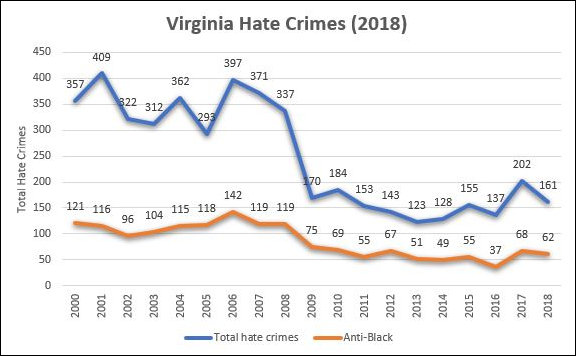The Virginia State Police have published their Crime in Virginia update for 2018, and it is worth noting what Attorney General Mark R. Herring is focusing on in a press release issued today — the fact that marijuana arrests increased 3.5% last year, more than tripling since 1999. No mention of hate crimes.
Last year Herring launched his bid for the Democratic Party gubernatorial nomination with a roadshow decrying a supposed surge in white supremacist hate crimes. But the number of total hate crimes in Virginia, including those allegedly perpetrated by whites and those allegedly perpetrated against blacks, declined last year, continuing a long-term downward trend.
Not only were there fewer hate crimes reported in Virginia last year, most of them were minor in nature. None were homicides, only one was arson, and only seven were classified as aggravated assault. Given how elected officials and the media have magnified the issue of race and ethnicity in the public discourse today, the fact that race- and ethnic-based hate crimes declined in the Old Dominion last year suggests that the public attitudes and behaviors are not nearly as polarized as those of the political class.
The number of total alleged hate crimes dropped from 202 in 2017 to 161 last year. The number of alleged hate crimes committed against blacks declined from 68 to 62. The number of alleged hate crimes against Hispanics tumbled from 10 to three, against Jews from 22 to 15, and against Muslims from eight to five. The number of alleged hate crimes based on sexual orientation fell from 38 to 23. Compare that to 1,452 assaults on police officers, of which approximately one-fifth resulted in an injury to the officer.
Also consider that these numbers reflect alleged hate crimes. They do not reflect actual convictions, nor do they account for the fact that a high percentage of reported hate crimes are bogus. As Kentucky State University professor Wilfred Reilly has concluded after extensive review of reported hate crimes in his book “Hate Crime Hoax, “It is probable that at least 15 percent of all reported hate crimes and hate incidents are hoaxes.”
Given the data, it is difficult to maintain a state of hysteria and alarm over a looming white supremacist threat here in Virginia. It may be a winning issue among Democratic Party activists, but it won’t resonate with the broader public. Herring is prudent to drop the issue.
Empirically, Herring stands on firmer ground when he talks about the continued rise in marijuana arrests from fewer than 10,000 in 1999 to nearly 30,000 last year. And he stands on firmer ground in making marijuana arrests a racial issue. Despite comprising 20% of the population, African Americans accounted for 46% of all first-offense possession arrests between 2007 and 2016.
That doesn’t mean I necessarily agree with the inferences Herring draws from those numbers, just that he doesn’t appear to be torturing the data. Still, the first rule of journalism is to never trust a politician. Elected officials routinely cherry pick data to score rhetorical points. Time permitting, I will check to see if his assertions withstand scrutiny.



